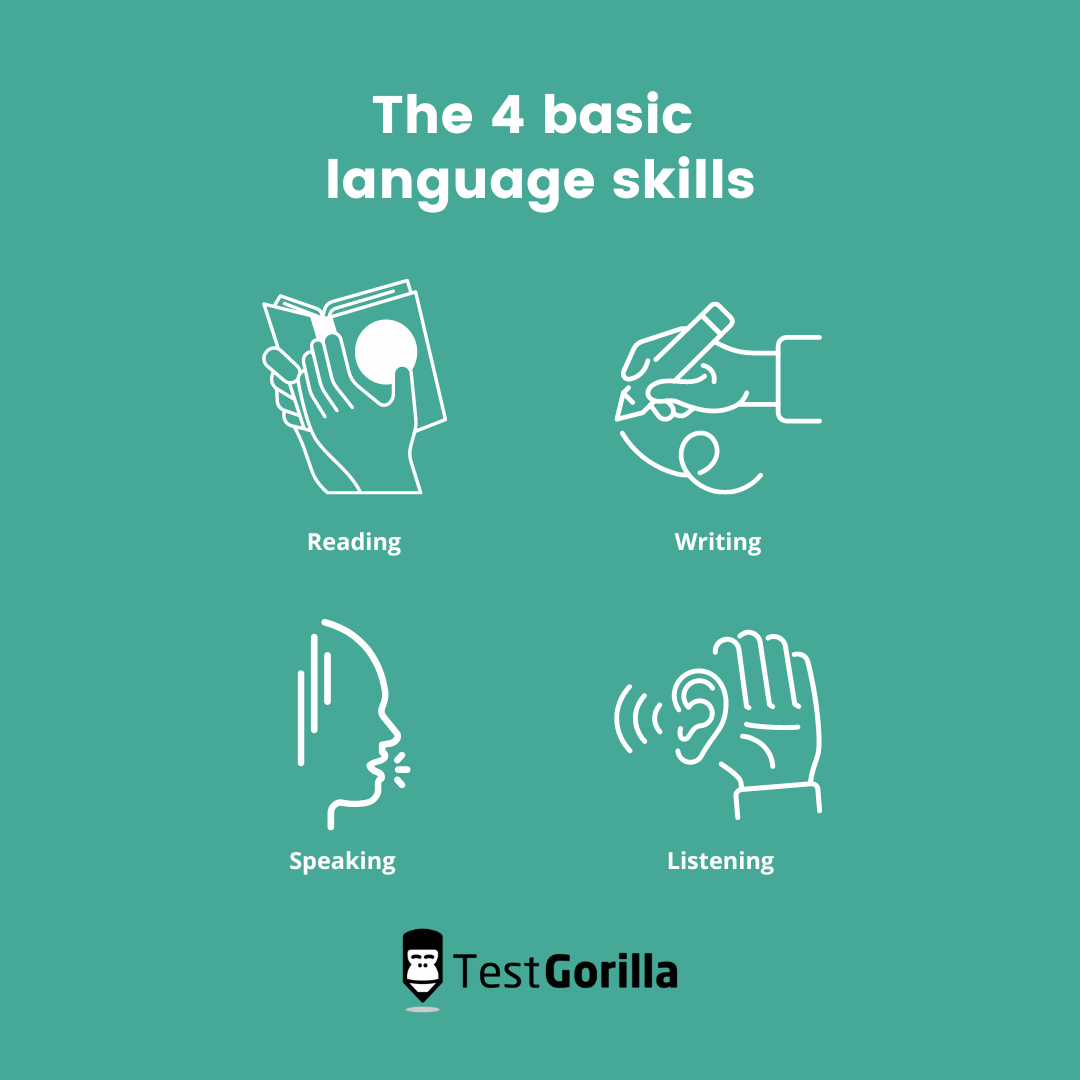While recruiting Italian speakers, you must ensure your candidates understand the language enough to function in the role.
With about 61.8 million people[1] speaking Italian worldwide and the increasing demand for bilingual workers,[2] finding and classifying applicants according to their level of fluency can be difficult. It can not only be tasking and stressful but also leave you vulnerable to mis-hires.
As a recruiter, you must ensure that each candidate you hire has skills that suit their roles and can drive your company’s success. If they’re not native-speaking Italians, you must check that they can hold stable conversations in Italian while dealing with clients.
In this article, we will explore the various skills needed to be fluent in Italian and how different levels of language proficiency are classified.
We’ll also describe the best ways to check for Italian proficiency, such as using an Italian skills test.
Table of contents
What are language skills?
Language skills are communication abilities that help a person convey information clearly to others.
No matter the language you speak, the main aim of communication is to exchange information with another party in a way you can both understand, and these skills help you achieve this goal.
If your skills are inadequate, it’s difficult to share information with another person.
What are the 4 basic language skills?
The basic language skills are as follows:
1. Reading
Reading is the act of understanding written text, which can vary in complexity. Many employees require this skill to complete their work successfully. Employees who need to read emails, letters, proposals, and invoices must have a good grasp of the language to be effective in their roles.
Therefore, when you’re recruiting for a role that requires Italian language skills, it’s essential to include a means of checking candidates’ reading comprehension.
2. Writing
Applicants who are skilled at writing can easily draft understandable text in a given language. They are able to form coherent sentences and paragraphs that clearly convey their intended message.
It’s necessary to check candidates’ writing skills before you hire them to ensure you employ staff who write clearly and correctly. Your employees must be adept at writing in Italian if you want your organization to thrive and succeed in Italian business relations.
3. Speaking
Proficiency in verbal communication is also a vital language skill. Employees who are fluent in Italian can easily communicate in the language.
Your applicants should be able to clearly present their ideas and understand spoken information. They must have a good understanding of Italian grammar, vocabulary, and intonation.
4. Listening
Listening is a passive language skill since most people develop it even before learning to speak the language. The act of listening involves hearing and understanding spoken language. A candidate with excellent listening skills grasps the implications of terminologies and intonation.
What are the levels of language proficiency?
The Common European Framework of Reference for Languages (CEFR) recognizes and classifies fluency into six levels: A1, A2, B1, B2, C1, and C2. The scale, as shown below, ranges from beginner (A1) to native-level (C2) fluency.
A1: Beginner
Candidates at the A1 level of Italian proficiency have only a basic knowledge of the language. They can understand simple words and phrases but cannot properly engage in Italian conversation aside from very basic interactions.
A2: Elementary
At this level, applicants have a slightly deeper understanding of Italian and can engage in simple conversations with coworkers. They can talk about their jobs and understand brief instructions others give to them.
B1: Lower-intermediate
Those who have reached the B1 level of Italian proficiency possess moderate knowledge of Italian. They can read and engage in light conversations in the language. However, complex conversations are still difficult for them to understand.
B2: Upper-intermediate
Candidates at the B2 level of Italian fluency easily communicate using the language. They have little trouble reading and comprehending complex text in Italian but are prone to making mistakes from time to time. At this level, they also have an understanding of basic intonation.
C1: Operational proficiency
At the C1 level of Italian, applicants have operational language knowledge. They can express themselves clearly in writing and speech and are able to take part in demanding conversations without making errors.
C2: Native-level fluency
Candidates at the C2 level of Italian fluency possess fully developed Italian skills. They can independently engage in demanding conversations and understand specialized written text.
These applicants have excellent Italian intonation, a solid understanding of Italian terms, and the ability to use Italian grammar properly. Your company can recruit such candidates into positions that require a high-level understanding of Italian and all its aspects.
What are the best ways to test for Italian fluency?
There are numerous ways to test candidates’ proficiency in Italian. The following are reliable methods for assessing Italian fluency:
1. Phone interviews
One way to test Italian fluency during recruitment is by conducting short interviews via phone calls. This method enables you to evaluate an applicant’s reading skills, but you can also use it to assess their listening skills.
However, it can be difficult to thoroughly examine a candidate’s reading and writing skills in a phone interview since there is no way to monitor them visually as they carry out the tasks.
2. Video interviews
Video interviews are also an effective way to test Italian fluency. With apps like Zoom, Google Meet, or Microsoft Teams, you can assess applicants’ language skills through an online interview.
Furthermore, video interviews enable you to learn more about candidates’ personalities and character traits. However, you’ll need to properly plan these meetings and keep them short so that they fit within your and the candidates’ schedules.
3. Asynchronous video interviews
An alternative to live video interviews, asynchronous video interviews enable candidates to record video responses to predetermined questions. You can also easily incorporate this method of testing applicants’ Italian proficiency into an Italian language test.
With TestGorilla, you can create custom video questions and add them to your Italian skills test. Then, your candidates can answer the questions by recording a short video. You can use their responses to assess their communication skills and learn how they express themselves.
4. Language tests
Giving applicants an Italian language test is an ideal way of evaluating their fluency. Using an Italian proficiency test helps save time, resources, and labor that you can invest in other tasks.
Moreover, you can gain insight into your candidates’ personalities by including other tests. Adding a personality test or role-specific test gives you a comprehensive view of your applicants and helps you understand how they would perform in a position.
Recruiting for Italian-speaking employees is easy with the right strategy
Finding proficient Italian employees doesn’t have to be difficult.
In fact, with a good recruitment strategy and an Italian pre-employment test to streamline the process, you can rest assured that your business will receive only the best applicants for the role.
TestGorilla offers many pre-recruitment tests that you can use to thoroughly examine your candidates before conducting interviews without having to sort through numerous CVs.
Our assessments ensure bias-free recruitment so that you hire goal-driven applicants who can boost your organization’s success. It’s free to get started with TestGorilla, and you immediately get access to a demo on our website after signing up.
Sources
“Italian – Worldwide distribution”. WorldData.info. Retrieved August 10, 2022.
Colón, Ingrid. (April 25, 2019). “New Research Examines the Economic Benefits of Bilingualism”. New America. Retrieved August 10, 2022.
Related posts
Hire the best candidates with TestGorilla
Create pre-employment assessments in minutes to screen candidates, save time, and hire the best talent.
Latest posts
The best advice in pre-employment testing, in your inbox.
No spam. Unsubscribe at any time.

Hire the best. No bias. No stress.
Our screening tests identify the best candidates and make your hiring decisions faster, easier, and bias-free.
Free resources
This checklist covers key features you should look for when choosing a skills testing platform
This resource will help you develop an onboarding checklist for new hires.
How to assess your candidates' attention to detail.
Learn how to get human resources certified through HRCI or SHRM.
Learn how you can improve the level of talent at your company.
Learn how CapitalT reduced hiring bias with online skills assessments.
Learn how to make the resume process more efficient and more effective.
Improve your hiring strategy with these 7 critical recruitment metrics.
Learn how Sukhi decreased time spent reviewing resumes by 83%!
Hire more efficiently with these hacks that 99% of recruiters aren't using.
Make a business case for diversity and inclusion initiatives with this data.



















